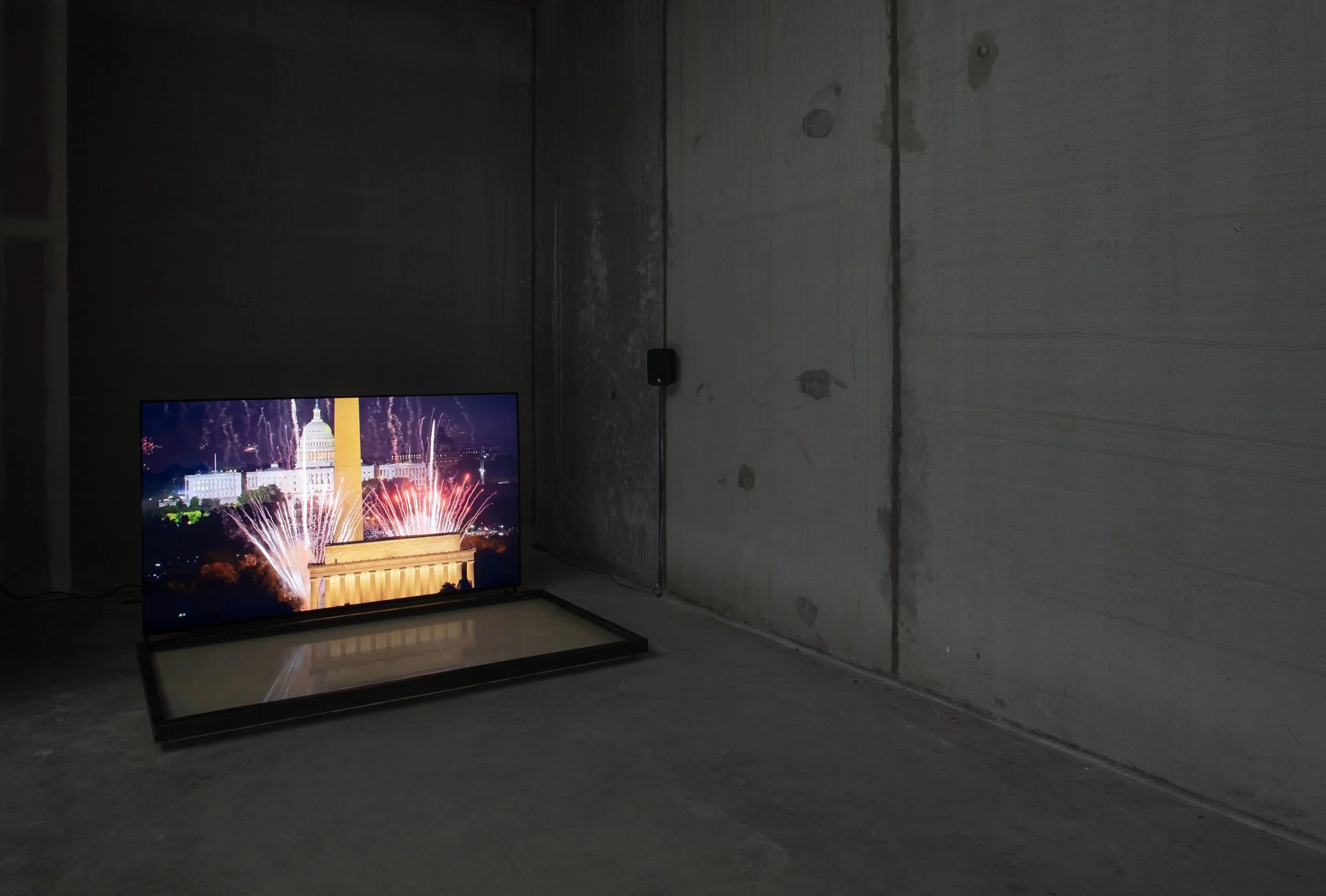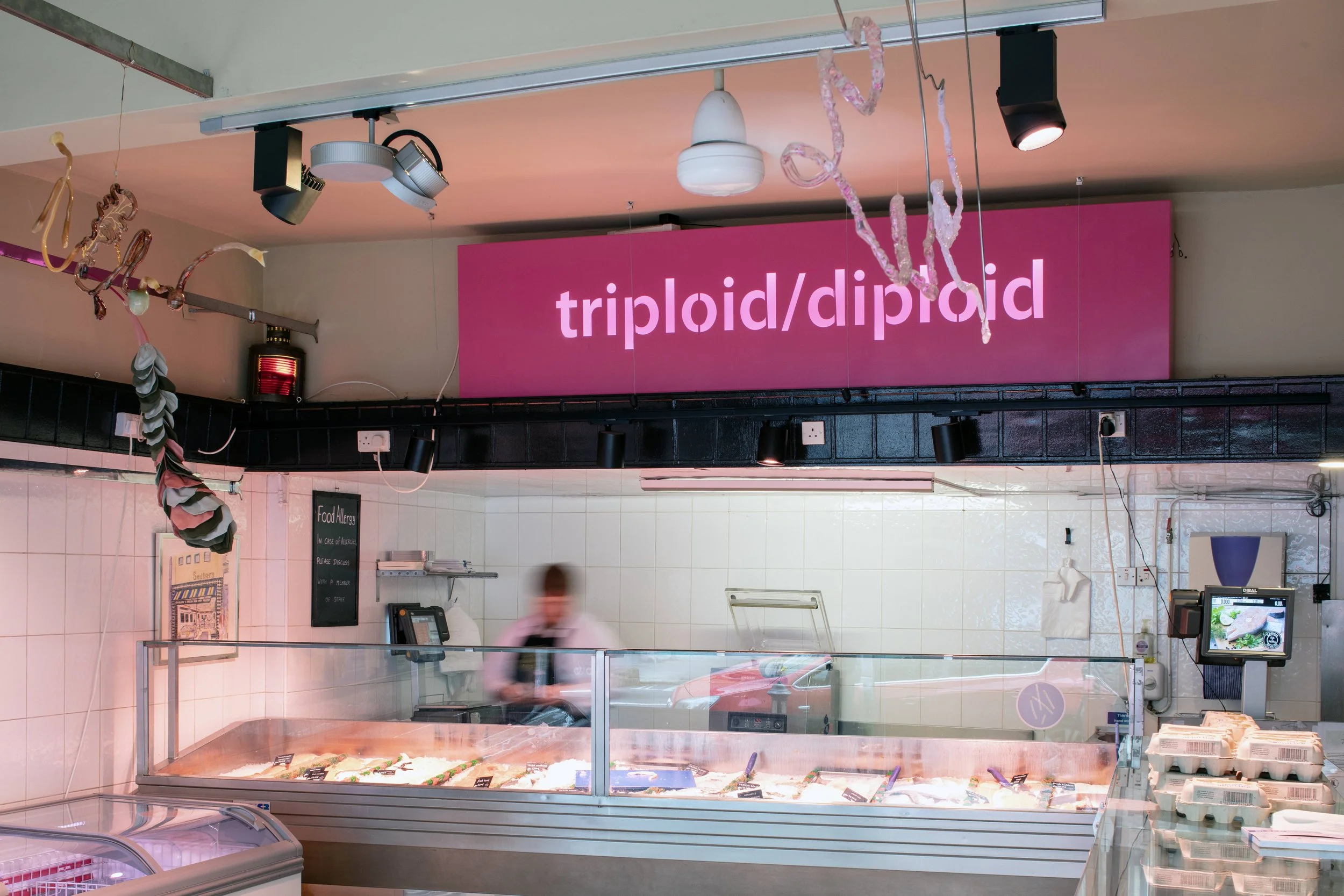On Organization and Collaboration at EVA
Biennials and triennials—place- and event-based exhibitions—assume increasing prominence on the contemporary art world’s stage, having burgeoned in significance since the 1980s, as Paloma Checa-Gismero writes in Biennial Boom (2024). Founded by artists in 1977, EVA, Ireland’s biennial based in Limerick, is part of this boom, producing a biannual city-wide exhibition in tandem with an international curator, this year Eszter Szakács. Now on view through October 26, Szakács’s approach, titled It Takes a Village, is one informed by EVA's staff and structure and responds to elements of its new strategic plan of sustainability, development, and engagement.
Applying the idea of a village in both a global and ecosystemic sense, this year's EVA hosts projects across thirteen venues as varied as a fishmonger's (Ciarán Ó Dochartaigh's Triploid / Diploid, 2025) or a burger place (Noor Abuarafeh's lecture performance) through Szakács’s guest program, as well as Platform Commissions selected by Iarlaith Ní Fheorais and Roy Claire Potter. The platforming of Irish artists alongside those from elsewhere not only weaves together aesthetic and political gestures, amplifying parallel experiences despite and through the particularities of place, but is unique to the “-ennial” space, which often risks complete homogenization in bringing artists from the international exhibition circuit to a specific and localized context.
But how does this work of building audience and artist capacity continue locally after the event of an international biennial is over? I chatted with both Szakács and EVA’s Director and CEO, Matt Packer, to discuss the audience and the legacy of event-based, place-driven exhibitions. Our conversation evolved into considering the connective tissue between local and global, collective and single-authorship, and longevity for models like EVA, and suggests that annual, site-specific exhibitions need a mix of both organizational and curatorial creativity to sustain.
Leah Triplett: In Biennial Boom by Paloma Checa-Gismero, she discusses the concept of an “international art audience” that attends these biennials. How do you consider both the international art audience and the Limerick local audience? How do you reach both?
Matt Packer: Most of our audience is local, or at least an Irish audience. There’s a relatively small portion of people who travel here as part of the Biennial circuit. Less than 10% of our audience comes from beyond Ireland or the UK. At the same time, we do have an international communication outlet, and that’s important. It’s not a binary. It’s important to us to stand up and be counted among the circuitry, because that makes a difference to the kind of psychology and confidence of a small, regional art scene.
Eszter Szakács: In terms of a project that plays with what audience is, Reza Afisina proposes a mobile cultural platform, essentially a cart, that can be pulled into different contexts. What this platform can do, or what it can be used for, is an experiment that Reza is working on in collaboration with Daithí Mac Cruitín. This is an unfolding project that can be used by basically anyone in Limerick. It’s been used as a stage for a music act as well as a merchandise stand. It’s designed to be alive in its own way, and Reza has titled it Grass, so it’s also about how a community can grow together. But otherwise, it's just a multifunctional cart.
As an outside curator, the first point of significance was my relationship with the EVA team. I wanted to think about how we work together, because I didn’t want to come up with something that the team just realizes. I wanted to collaborate.
LT: I love how that’s really in the DNA of the theme, It Takes a Village. You wrote in the program guidebook that this edition’s “development has been more defined by method than any single theme.” Can you talk about that?
MP: EVA has a four-decade history of appointing international curators, and it’s sobering when you realize that after four decades, Limerick is not abuzz with curatorial knowledge. The ways in which the city has been able to develop capacity and legacy in relationship to curatorial knowledge are really, really limited.
That isn’t to discount all the brilliant work that those curators have done over the years, but from an organizational perspective, we realize that we need to do something that shifts the balance and makes it more co-developmental so that curators aren’t coming here, doing a good thing, and leaving. Ultimately, this led to Eszter’s appointment, and she took on this idea of returning the invitation directly to the curatorial team.
ES: EVA’s strategic plan was also what I was interested in when we met. This collaborative model is actually more sustainable, I think. If the role of the curator is changing, I think this could be an example of experimenting with that.
LT: Over forty-one editions, what is the residue of each edition onto the next? Are there theoretical or practical considerations that build onto the next, or does each one feel very fresh?
MP: I don’t think it’s a question asked of biennials enough. There is so much that happens at the ground level—the operational level—to make these large-scale, complicated projects happen that just doesn’t find its way into the biennial discourse. This is an interesting question because the truth falls somewhere between the curatorial and operational sides of things.
You’ll see it in our guide, but there are some ongoing projects and a program we’ve put on called Legacy, which is a catch-all for anything lingering in the city from previous editions. There is also our initiative Never Look Back, which is basically a history of the organization as told through different spaces that have accommodated projects or presentations.
But quite honestly, it does feel like with each edition, you’re kind of starting from scratch a little bit. Some of that has to do with boring factors, like how we’re funded on an annual basis—meaning we have to make a new proposal each time. The other factor is how art labor is so precarious and volatile, and very often, there is a completely different team involved from one edition to the next.
ES: Looking back to when I was appointed and realized I had to come up with something, I felt like I had to propose something new. And even if I tried not to succumb to all these kinds of curatorial assumptions, the expectation of doing something new was still there. I would love to see what would happen if EVA curated an edition itself. What kind of international would that be?
MP: There are other kinds of authors of the program, but when EVA is featured in the press, it mostly focuses on the curator. Art or art media needs a sort of figurehead: someone to shoulder it all and be a kind of unique, individual voice. That’s something we’ve struggled with, and in this edition, we wrestle with it thematically.
LT: Do you think that’s because the art field still heavily values the singular, individual artist in the studio, so it makes sense to us to also value the singular curator?
MP: I think so. But also, in Ireland, we’re kind of generally insecure about how we are perceived by the rest of the world. We’re used to being this small, provincial island that no one really understands. I’m not trying to make some sort of quasi-nationalist argument, but I think it does play into a kind of Irish post-colonial anxiety about how well-known we are.
This is just an anecdote, but we just had a press trip for EVA’s opening days, and one of the press there was really keen to ask why Irish visual artists aren’t better known. And I think it really depends on where you ask that question from, for a start.
LT: Kurt Cobain said one of my favorite things about this kind of question when someone asked him how it felt to put Seattle on the map, and he responded, “What map?”
MP: One of the things we continue to think about is whether we should continue the international piece. Ireland has changed, but we are still an island off an island. We don’t have organic connectivity to the vast ways of the world, in terms of cultural mobility or infrastructure. We’re not trying to pursue an isolationist pose just to make ourselves more comfortable and more culturally resourced. So I think we will always work with international curators because I think that if you can get that right, you can build something that benefits both contexts.
LT: It seems like with this edition, you’re building reciprocity. Eszter, what experiences are you taking from your work in Limerick to apply to other parts of your practice? Has working on EVA shifted any thinking in other projects?
ES: I’ve been a longtime curator and a member of OFF-Biennale Budapest, which is also a grassroots biennial in Hungary. It’s a very different context, and it is grassroots politically, because it doesn’t take any funding from the Hungarian government. We decided that our curatorial team would not be just us but also [other curators] from Hungary—locals—because the mission of the biennial is to contribute to the local art scene. The idea was that the locals know what’s best for the local art scene. So I am super interested in building infrastructure [in Limerick] and thinking long-term, and not just in terms of a one-off.
I look forward to our feedback session once this edition is over to learn how we can depart from the classic curatorial model to contribute meaningfully to EVA while also being aware that I am not part of the organization.
And I’m thinking about ways I can continue my work with the EVA team and Irish artists, and in Ireland in general, in whatever smaller formats. I’m also still thinking about the weight of elements in an equation of the curatorial and the organizational—what does that equal? I don’t have an answer to that, but I think there has to be a mix of both. I think that maybe, on a theoretical level, that’s my biggest takeaway so far.
This interview was edited for clarity and length.
The 41st EVA International runs until October 26, 2025.






